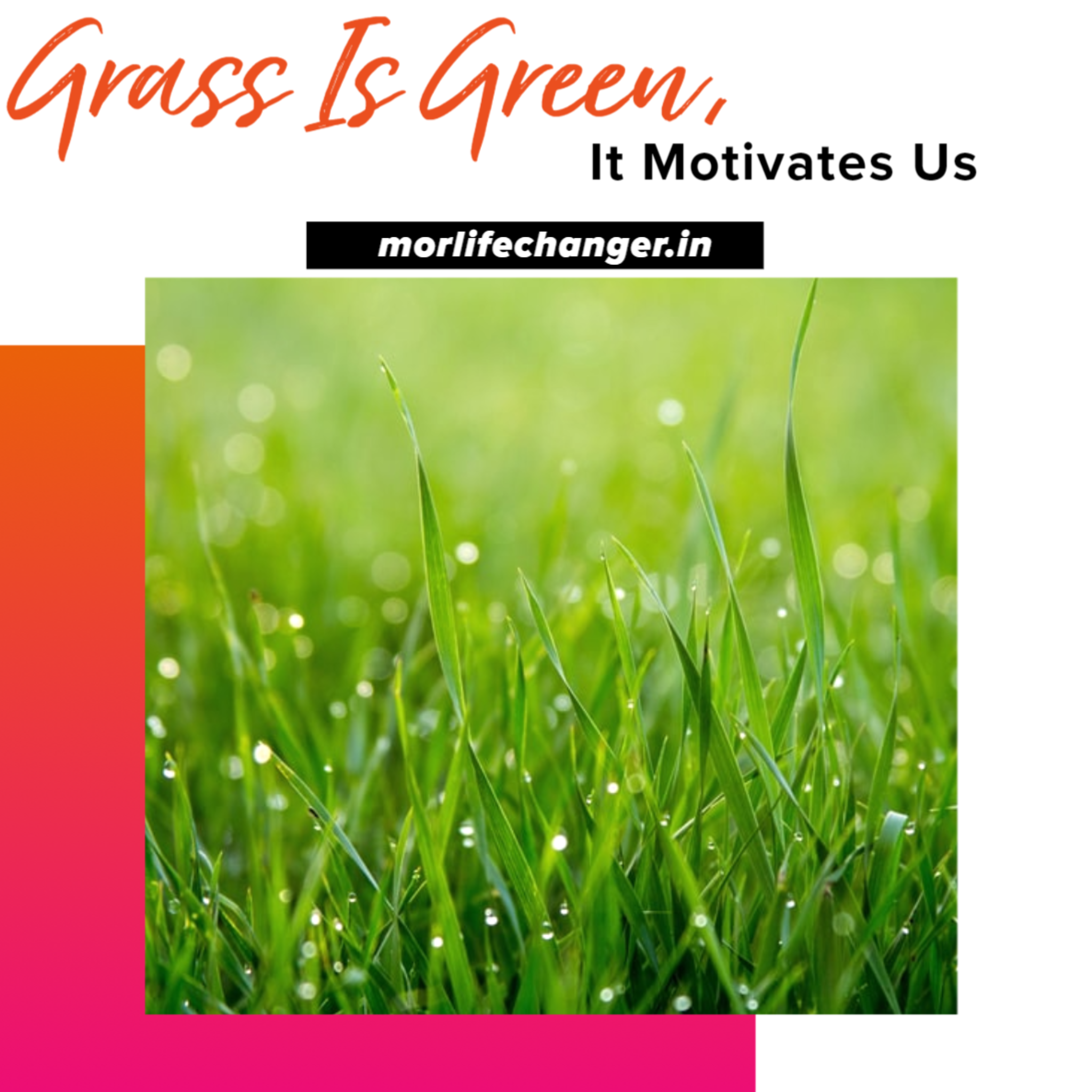Grass is green and it motivates us which shows the love for nature. It makes the land beautiful. As Grass is green and it motivates us because it makes the land beautiful. Beyond color, grasses offer a wealth of beauty.
Grass also offers us interest derived from translucency, line, form, texture, scale, sound, movement, and seasonal dynamics. After all he landscape looks different from every blade of grass. Although the green color of grass is apparent to the casual eye. Developing an awareness of grasses’ will enrich your experiences with them, in both the garden and the larger landscape.
Grass beautify our surrounding
Get close to grass and you’ll see a star. There was after all no mystery in the end of love, no mystery but the mystery of love itself, which was large certainly but as real as grass, as natural and unaccountable as bloom and branch and their growth.
Grass is much more than just an beautifying agent of your back garden. Grass plays an important role in production of crops. From agricultural point of view , grass is important in helping to feed the growing population of humans as well as animals.
With roughly 20% of the critical vegetation being made up of grass, this crop is pretty important to keep everything turning the way it should – and making the world a “green” place.
Grass holds soil and water in its roots
Planting of improved varieties of grasses on the risers will not only bind the soil but also provide a rich source of fodder for the livestock All the exotic varieties will not be equally effective to favor the soil conservation and cereal crop production in a given locality. The land types and site condition may affect the root and foliage systems of the grasses. Different grasses may have different uses in the locality. It prevents soil erosion
Also read – Everything is fair in love , war and business
How man is destroying these green grass
People are constructing buildings on the land of these green grass and destroying nature. As a result of human’s effort on nature, greenery is gone and nature is becoming worse. Farmers scrap or slice the natural grasses on the risers every year before the cultivation.
The farmers reported that slicing the terrace walls prevents collapse of the riser in the monsoon, adds fertile soil to the terrace below, and minimizes insects, diseases, and rodent problems. But this practice increases soil erosion . As some varieties grass is also food for humans as well as animals . But the saddest thing is there is less plantation of grass as compared to consumption of grass.
Grass promotes greenery
As the color depicts the green nature and ecosystem. Therefore grass is not only food but promotes greenery. Grass is green and it motivates us can truly be fulfilled when we go out to enjoy the greenness of nature.
Are you interested in some International news
Without grass life in this whole world will extinct
Grass is the first stage of the food cycle as herbivorous animals eat grass. The carnivorous animal eats herbivores which is the second stage of the food cycle. And finally omnivorous animals eat both carnivores and herbivores. If the first stage won’t be there, the next two stages will also get extinct. Grass plays a major role in the global food production industry.
The growing world population and the increasing prosperity enjoyed by ever-higher numbers of people are leading to a greater demand for protein-rich foods. That means that the demand for dairy products just keeps on growing. Grass is the main building block for nutritious dairy products: it is the cheapest source of milk protein. Grass that is developed from just the right balance of genetics and technology makes for a healthy cow that gives the very best possible milk.
No longer grass is green with a growing population
From our early childhoods, we instinctively come to think of grass in happy, positive terms: grass surfaces can be platforms for considering games, summer parties or escapes away from urban landscapes. In every season, grass will offer nature’s pleasures to people around the world, and the beauty of Mother Earth – grass-covered lawns, hillsides and prairies will also help prevent erosion by keeping soil in place with their root systems. But there has been a decline in the percentage of total grass available in the whole world which is leading to an increase in green gas effect.
Cremation of dead body on land
Grass is home for 12000 species
Bees.
Bison (also called buffalo)
Butterflies.
Elephants.
Giraffes.
Greater rhea.
Ground squirrels.
Hyenas.
Pampas
Prairie
Savannah
Steppes
Veld
Bison
Ostrich
Lion
Giraffe
Hyena (and cheetah!)
Ground squirrel
A meadow
Butterfly
Bee gathering pollen
Benefits of grass
Grass has several functions. We cannot digest it and yet it is one of the most important resources for our food production: animals eat grass and we eat animal products such as meat, eggs and milk. Furthermore, we also use grass in other ways: for sport, recreation and to brighten up gardens and public spaces. This plant also has important ecological functions: it protects against soil erosion, it absorbs water, it purifies the air we breathe and so on.
What do we learn from these ?
Most people take grass for granted but we shouldn’t forget that grass plays a very important role in our lives. Scientists all over the world are working on research, improvement, breeding and cultivation of this very important crop. This is the reason the grass is green and it motivates us.
Quotes on green grass
“The grass is always greener where you water it.” – Unknown
“Green is the prime color of the world, and that from which its loveliness arises.” – Pedro Calderon de la Barca
“The grass is not, in fact, always greener on the other side of the fence. Fences have nothing to do with it. The grass is greenest where it is watered.” – Robert Fulghum
“Green grass, blue skies, and a gentle breeze remind us of the simple pleasures that nature gifts us every day.” – Unknown
“The sight of lush green grass under our feet has a calming effect, grounding us in the beauty and abundance of the natural world.” – Unknown
“In the embrace of nature’s green carpet, worries fade away, and the soul finds solace in the serenity of the surroundings.” – Unknown
“The beauty of green grass lies not just in its color but in its resilience, bending but not breaking even in the face of storms.” – Unknown
“Walking barefoot on green grass, we connect with the earth, absorbing its energy and finding a sense of rejuvenation.” – Unknown
“The presence of green grass signifies life’s eternal cycle of growth, reminding us of the infinite possibilities that lie ahead.” – Unknown
“Green grass whispers secrets of renewal, inviting us to shed our worries and embrace the freshness of each new day.” – Unknown
Quotes on power of green grass
“The greenness of the grass is the living proof that Mother Nature never fails to offer us a refreshing oasis in the midst of life’s challenges.” – Unknown
“Green grass stretches like a soft carpet, inviting us to lay down our worries and find solace in the embrace of nature’s tranquility.” – Unknown
“The vibrant green of the grass reminds us that even in the harshest conditions, life persists, and beauty can emerge from the most unexpected places.” – Unknown
“Walking on green grass is like walking on nature’s welcome mat, inviting us to slow down, breathe in the fresh air, and reconnect with the earth beneath our feet.” – Unknown
“Green grass is nature’s symphony of renewal, a reminder that even after the coldest winters, spring always brings forth new growth and vitality.” – Unknown
“Green grass whispers tales of resilience, as it bends but never breaks under the weight of storms, reminding us of our own capacity to endure and flourish.” – Unknown
“The lushness of green grass mirrors the abundance of possibilities that await us, encouraging us to embrace change, take risks, and explore new horizons.” – Unknown
“Green grass symbolizes the promise of a fresh start, a blank canvas upon which we can write our own stories and create the life we desire.” – Unknown
“Gazing upon green grass, we witness nature’s masterpiece, a perfect blend of simplicity and intricate details that inspire awe and wonder.” – Unknown
“The color green in the grass is a symbol of hope, reminding us that even in the darkest times, there is always a glimmer of light and the potential for growth.” – Unknown
Quotes on serenity of green grass
“Green grass whispers the secrets of nature’s vitality, reminding us of the eternal cycle of growth and renewal.” – Unknown
“The freshness of green grass is like a balm for the soul, rejuvenating our spirits and reminding us of the beauty that surrounds us.” – Unknown
“Green grass dances in the wind, a symphony of movement that reflects the joy and energy of life itself.” – Unknown
“Walking on green grass is like stepping into a world of possibilities, where every blade holds the potential for new beginnings.” – Unknown
“The vibrant hue of green grass is a visual feast, nourishing our eyes and uplifting our hearts with its natural splendor.” – Unknown
“Green grass is nature’s invitation to slow down, kick off your shoes, and embrace the simple pleasures of being present in the moment.” – Unknown
“The sight of green grass awakens our senses, reminding us to pause, breathe deeply, and appreciate the miracles of the natural world.” – Unknown
“Green grass is a testament to the resilience of nature, as it springs back to life after the harshness of winter, teaching us the power of perseverance.” – Unknown
“Lying on green grass, gazing at the sky, we are reminded of the vastness of the universe and our place within it, connecting us to something greater.” – Unknown
“Green grass is like a tapestry that blankets the earth, weaving together the colors of nature and inviting us to become part of its intricate design.” – Unknown
Quotes on small wonder of grassland
“Green grass is a testament to the resilience of nature, reminding us that even in the harshest conditions, life finds a way to thrive.” – Unknown
“The lushness of green grass reflects the abundance of nature, reminding us to embrace gratitude for the gifts that surround us.” – Unknown
“Green grass is a gentle reminder that growth requires nourishment, both in nature and in our own personal journeys.” – Unknown
“Walking barefoot on green grass is like receiving a gentle massage from Mother Earth, grounding us and connecting us to the present moment.” – Unknown
“Green grass holds the secrets of seasons past, whispering stories of resilience and rebirth with every step we take.” – Unknown
“The vibrant green of the grass serves as a canvas for nature’s artistry, inviting us to slow down and appreciate the intricate details.” – Unknown
“Green grass is a visual symphony that soothes our eyes and invigorates our souls, reminding us of the beauty that lies in simplicity.” – Unknown
“The color green in the grass symbolizes growth, prosperity, and harmony, inspiring us to cultivate those qualities in our own lives.” – Unknown
“Green grass is a living testament to the power of nurturing, reminding us that with care and attention, even the smallest seeds can flourish.” – Unknown
“Lying down on green grass, we surrender to the embrace of nature, finding solace and rejuvenation in its peaceful presence.” – Unknown
Quotes on peace of green grass
“Green grass is a reminder that even in a world of concrete, nature persists, offering us a glimpse of its everlasting beauty.” – Unknown
“The softness of green grass beneath our feet is nature’s way of reminding us to tread lightly and with kindness in this world.” – Unknown
“Green grass whispers the secrets of harmony, as each blade works in unison to create a carpet of tranquility.” – Unknown
“Green grass is a canvas on which nature paints its vibrant colors, inviting us to appreciate the artistry of creation.” – Unknown
“The scent of freshly cut green grass awakens nostalgic memories, transporting us to carefree days of childhood innocence.” – Unknown
“Green grass is a gentle teacher, reminding us to bend with the winds of change and adapt to life’s ever-evolving seasons.” – Unknown
“In the vast expanse of green grass, we find a space for contemplation and reflection, where the mind can wander and dreams can take flight.” – Unknown
“Green grass is a sanctuary for the weary, offering a place to rest, recharge, and find solace amidst the busyness of life.” – Unknown
“The beauty of green grass lies not only in its appearance but in the symphony of life it supports, from tiny insects to grazing animals.” – Unknown
“Green grass is a reminder that even in the midst of chaos and uncertainty, nature continues to flourish, offering hope and resilience.” – Unknown
Quotes on vitality of green grass
“Green grass is a testament to the Earth’s vitality, a living carpet that reminds us of the abundance and resilience of nature.” – Unknown
“The vibrant green of the grass is nature’s invitation to dance, to twirl in the beauty of the present moment and embrace the joy of life.” – Unknown
“Green grass is a gentle reminder that growth requires nurturing, just like our dreams and aspirations need care and attention to flourish.” – Unknown
“Walking on green grass is like a gentle massage for the soul, soothing our worries and reconnecting us with the earth’s healing energy.” – Unknown
“The sight of green grass brings a sense of serenity and calm, reminding us to find moments of peace amidst the chaos of everyday life.” – Unknown
“Green grass whispers the promise of new beginnings, as each blade represents a fresh start and an opportunity for growth.” – Unknown
“In the lushness of green grass, we witness nature’s artistry, a tapestry of colors and textures that invites us to find beauty in simplicity.” – Unknown
“Green grass is a symbol of vitality, a vibrant reminder that life’s challenges can be overcome, and new possibilities await us.” – Unknown
“Lying down on green grass, we surrender to the gentle embrace of the earth, finding solace and rejuvenation in its nurturing presence.” – Unknown
“Green grass is a reminder to be present, to slow down and savor the small wonders that surround us in the natural world.” – Unknown
Quotes on beauty of green grass
“Green grass is nature’s poetry, whispering the secrets of life and growth through every blade that dances in the wind.” – Unknown
“The emerald hue of green grass is a gentle reminder that even in the busiest of lives, there is always room for tranquility and rejuvenation.” – Unknown
“Green grass is a sanctuary where worries dissolve, and the soul finds solace in the simplicity and beauty of the natural world.” – Unknown
“Walking on green grass is like stepping into a world of possibilities, where each footstep carries the energy of new beginnings.” – Unknown
“The lushness of green grass is a symphony of nature’s generosity, providing nourishment and shelter for countless creatures.” – Unknown
“Green grass is a tapestry of resilience, bending and swaying with the rhythm of life, reminding us to embrace change and adaptability.” – Unknown
“In the embrace of green grass, we find a connection to our roots, grounding us in the beauty of the earth and our place within it.” – Unknown
“Green grass invites us to lie down and gaze at the sky, encouraging us to dream big and reach for the infinite possibilities that await us.” – Unknown
“The scent of fresh-cut green grass awakens memories of carefree summers and the freedom to run wild with joy and abandon.” – Unknown
“Green grass is a visual reminder that nature’s palette is filled with vibrant colors, inviting us to explore and celebrate its kaleidoscope of beauty.” – Unknown
Please join discussion on Facebook about world facts and its secret.




